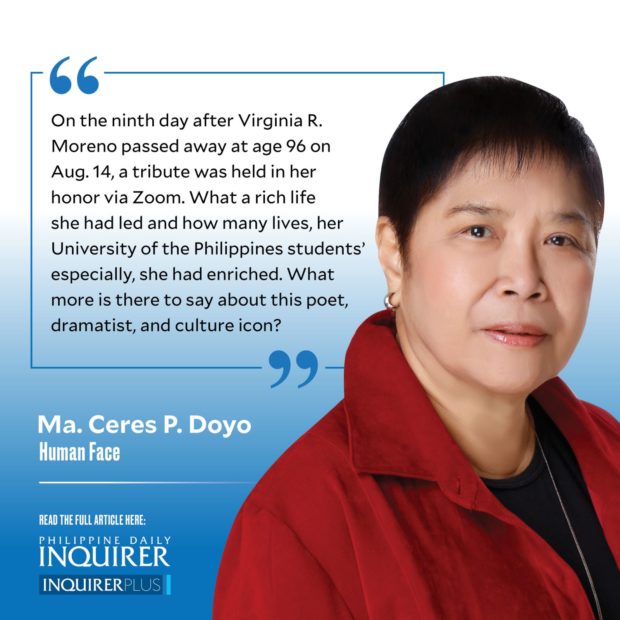The Tondo of Virgie Moreno

On the ninth day after Virginia R. Moreno passed away at age 96 on Aug. 14, a tribute was held in her honor via Zoom. What a rich life she had led and how many lives, her University of the Philippines students’ especially, she had enriched. What more is there to say about this poet, dramatist, and culture icon?
The last time I saw her was in 2018 at the UP Film Center where she held a photo exhibit on films and the showing of Kidlat Tahimik’s “Perfumed Nightmare.” My barkada, the Women Writers in Media Now, were her special guests. She came in a simple bright pink gown (by her late brother and fashion czar Pitoy, I presumed) and her favorite abalorio slip-ons. Her signature buko salad was to be served, she promised.
Some years earlier she had invited me to the Mama Sita anniversary musical where she came in a stunning purple terno. One did not refuse her invites especially when they came with handwritten notes, and the event was at the Cine Adarna of the UP Film Center, which she midwifed into being (and no one is to dispute that).
I did write about her in the Sunday Inquirer Magazine some decades ago. The piece, “The Tondo of Virgie Moreno,” was side by side “Tondo, changing and unchanging” that had me descend into Tondo’s seamy underside with veteran photographer Ed Santiago. So what a breather it was to be with Virgie showing us around the Moreno ancestral home in Tondo (she already had a home-café residence in Malate) and recalling her girlhood years in World War II and her life in and outside the university.
(She honored me with a lovely back cover blurb for one of my books, imagining me to be “a poet held captive.”)
Excerpts from “The Tondo of Virgie Moreno”:
But the poet returns often. Here she sometimes brings friends who wish to savor the Tondo of old. And why not. Tondo was cradle to many distinguished persons, among them Lakandula, Raha Sulayman, Andres Bonifacio.
Here distinguished writers first saw the light of day. Amado V. Hernandez, poet of the anakpawis, after whom Plaza Leon Trese has been renamed, Bienvenido Santos, Francisco Arcellana, Andres Cristobal Cruz (“Sa Tondo May Langit Din”), Armando Malay, Teodoro Agoncillo. A century or so ago, an Augustinian friar wrote of Tondo as a place where “men and women are addicted to poetry”…
“Ako, lahat ng dinadaanan ko, tinitikman ko (I tasted everything along the way). The flowers, the leaves. As a little girl hindi ako ma-
drama. Pitoy was. He was very business-minded. I gave away a lot of our tinda. I used to steal for my piano teacher, beggars, friends…
“Whenever the Japanese passed by we were raised with a rope to the ceiling and whenever there was an air raid, we all ran downstairs to hide. One time I went out alone with the birds and the rice I had stolen from the house. I saw a Japanese sentry at every corner. I did not know that my mother had me followed by a calesa. I was only 12 years old then.
“I was about three to four years old when I learned how to read. At first I went to the Belgian nuns for schooling. But I would get hysterical whenever I saw the nuns so I had to go to the Instituto de Mujeres for my catechism. I’m the only Moreno girl who went to public school…
(Fast forward.) “Pagpasok ko sa disco, tabi lahat.” That was in the 1970s, during the martial law years and she was not too friendly with the powers-that-be but too friendly with fugitives. And so an exile in Paris she became. “How will I come home and meet my stony race?” she wrote then. Martial law also saw the closing down of Indios Bravos, watering hole of artists, intellectuals, and activists…
The house on Juan Luna Street has stood up to the cruel elements—crime, pollution, congestion—that have creeped into the Tondo of old. The hand-shaped brass knocker on the door has been pried loose several times by antique hunters but it is still there, hanging on for homecoming Morenos.
Here, Virginia ever returns. The place figures in what she creates. In “The Onyx Wolf/Itim Asu” (play, film, ballet about the race suppressed), she celebrated the historical figures of Tondo of a bygone era. She wrote a play on the famous artists after whom the street where she lived was named. “Indio Spoliarium,” she titled her opus. It won her an award, but Virgie La Tondena, we heard, returned the prize.




















